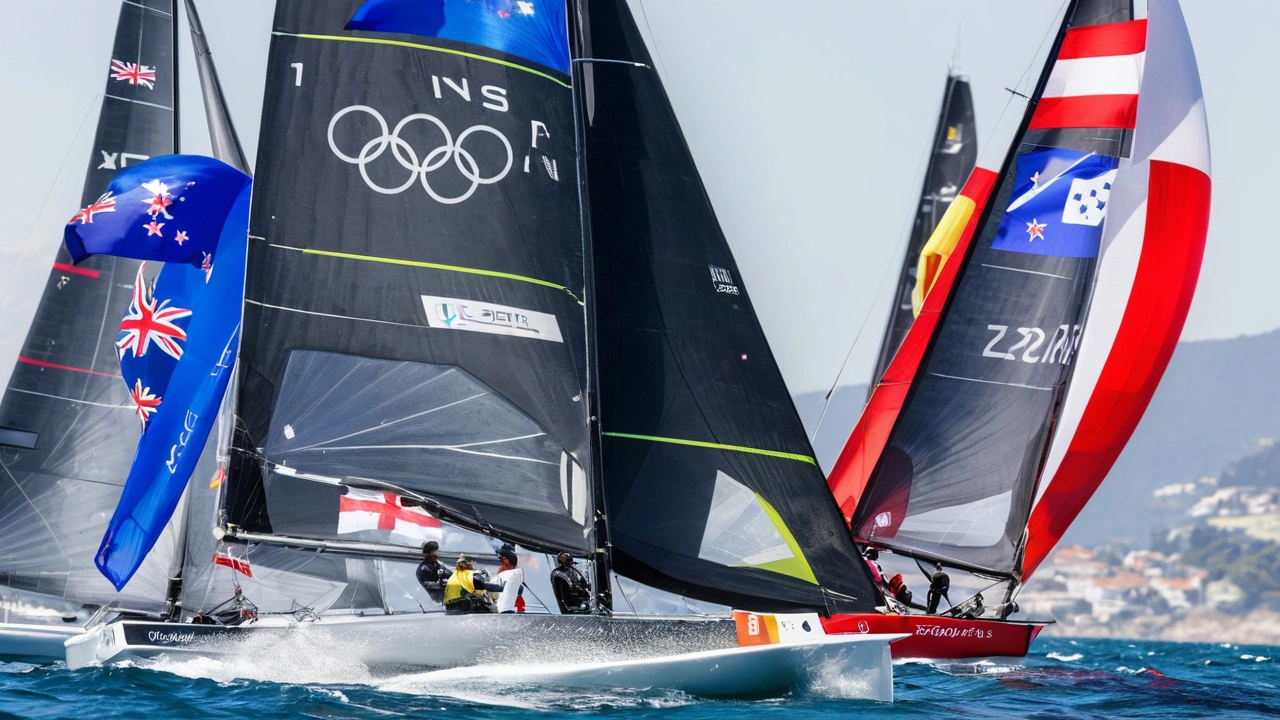
Understanding the Start of an Olympic Sailing Race
For those of us new to the world of Olympic sailing, the start of a race might seem like a chaotic blend of boats jockeying for position on the water. However, there is a method to the madness. The beginning of an Olympic sailing race involves a 5-minute countdown, which is crucial for sailors as they maneuver their boats to gain the best starting position. This countdown heralds the approach of a critical window where sailors must decide their precise position on the startline. The startline is typically set at a 90-degree angle to the wind and has two endpoints: the 'pin end' and the 'committee boat end.'
Choosing sides on the startline is strategic, affecting the sailor's initial race direction. The startline may be 'biased,' meaning one end is notably closer to the first mark than the other, making the starting position even more competitive. Sailors must quickly assess and adjust to these biases, making rapid decisions about whether to position themselves on the left or right. A perfect start isn't just about speed, it's about positioning, timing, and wind awareness.
Weather-Related Delays in Olympic Sailing
If you've ever tuned in to watch Olympic sailing only to find the event delayed, the reasons often boil down to weather conditions. Wind plays a pivotal role in sailing, and races require specific wind parameters to proceed. Wind stability and force must be just right: too little wind and sailors can’t generate the speed needed for a competitive race; too much wind can be dangerous and unwieldy. Typically, wind speeds below 5 knots are considered too low, while speeds exceeding 30 knots can lead to postponed races due to safety concerns.
Wind direction changes are another factor that can result in delays. If the wind shifts significantly, the race committee may need to reposition the course to ensure fairness and challenge. While frustrating for viewers, these precautions are essential for the integrity and safety of the sport. Patience is key when watching sailing, as the ebb and flow of nature dictates the race schedule.
Common Sailing Terms and Concepts
For spectators unfamiliar with sailing jargon, the sport can sound like a foreign language. Understanding a few key terms can drastically improve your viewing experience. Here are some basic sailing terms:
- Knots: The unit of measuring wind speed. One knot equals approximately 1.15 miles per hour.
- Spinnaker: A large, colorful sail used predominantly when sailing downwind. It’s typically seen on 49er boats, an Olympic class.
- Pin end: The end of the startline opposite the committee boat. Often marked by a buoy.
- Committee boat end: The end of the startline marked by the race committee’s boat, which signals the start of races.
- Biased startline: When one end of the startline is closer to the first mark, offering an advantage to sailors starting from that end.
Mastering these terms not only helps in understanding the race but also deepens appreciation for the strategy and skill involved in Olympic sailing.

The Role of Wind in Olympic Sailing
Wind is the lifeblood of sailing. Its speed and stability are critical to race conditions, and sailors must be adept at reading and manipulating wind patterns. During races, sailors constantly observe wind changes, which can mean the difference between victory and defeat. Despite technological advances, detecting slight variations in wind speed and direction remains a highly skilled practice.
Olympic sailors use flags and other visual markers to gauge wind direction and speed. Wind meters affixed to their boats provide real-time data, but gut feeling and experience often guide their split-second decisions. Understanding the wind's role sheds light on why delays happen; too much turbulence or unpredictable gusts can make the waters unsafe and the race unfair.
Picking the Perfect Position on the Course
As strategic as a chess match, positioning on the course is critical in Olympic sailing. Sailors must pick their spots with precision, considering wind direction, competitor positions, and course layout. Navigating the optimal path involves a blend of tactical foresight and physical agility.
The racecourse in Olympic sailing isn't a straight line. It consists of different marks and legs, guiding sailors through a multi-way point system. The first leg often leads upwind, requiring sailors to zig-zag, or 'tack,' to move upward against the wind. Subsequent legs may allow for various points of sail, including the deployment of the spinnaker and intense downwind racing.
The Technical Side: Understanding the Boats
Olympic sailing features several classes of boats, each designed with specific characteristics for wind conditions and maneuverability. Popular classes like the 49er, Laser, and Finn each have unique traits that impact sailing strategies.
The 49er is known for its speed and agility, featuring a lightweight frame and delicate sails suited for fast, tactical racing. Lasers are typically singular manned, favored for their simple yet challenging design. The Finn class, often raced solo and noted for its robustness, can be seen in varied wind conditions. Understanding the types of boats and their specific uses provides an essential layer to appreciating the complexity of Olympic sailing.

Spotlight on the Spinnaker
If you've ever seen a burst of vibrant colors darting across the water, you've witnessed a spinnaker in action. This eye-catching sail is mainly used when a boat is sailing downwind, essentially acting as an accelerator by catching wind from behind. Its larger surface area compared to standard sails enables faster speeds, making it a thrilling aspect of the sport.
The spinnaker adds spectacle to Olympic sailing with its dynamic appearance and practical efficiency. Boats like the 49er class frequently utilize this sail during downwind legs, marking some of the race’s most exhilarating moments.
Challenges and Tactics in Olympic Sailing
Sailing is often perceived as a straightforward contest of speed, but the sport's depth extends far beyond that. Strategies such as 'covering' opponents’ wind, managing sail settings, and calculating the best tacks and jibes are integral to securing victory. Each boat’s crew must communicate effectively, making rapid decisions to adapt their approach relative to competitors and the ever-changing wind.
Weather forecasts, tidal data, and visuals from water markers all feed into these choices. Elite sailors are analytical, blending on-spot tactical finesse with rigorous pre-race planning. These combined efforts culminate in optimal performance, revealing the nuanced and strategic elements behind each competition.
The Importance of Team Work and Communication
Team-based classes in Olympic sailing, such as the 49er, require coordinated efforts between crew members. Whether tacking or deploying the spinnaker, synchronized movements are essential. Clear, concise communication enables efficient sail adjustments and tactical shifts during the race.
Roles within the team are clearly delineated. One member manages the helm, while others adjust sails or act as spotters for wind changes. This collaboration requires both physical prowess and mental acuity, showcasing the well-rounded skills necessary in Olympic sailing.
In conclusion, Olympic sailing encompasses a combination of skill, strategy, and resilience against nature's forces. By breaking down these elements into digestible lessons, we aim to demystify the sport for new spectators. Through understanding the intricacies of starting positions, wind impact, and the technical specifications of different boats, you can fully appreciate the brilliance and complexity behind what may seem like a simple race on water. Embrace this fascinating sport with greater insight, and you'll find each race packed with tactical maneuvers and split-second decisions that make sailing a truly captivating Olympic event.




